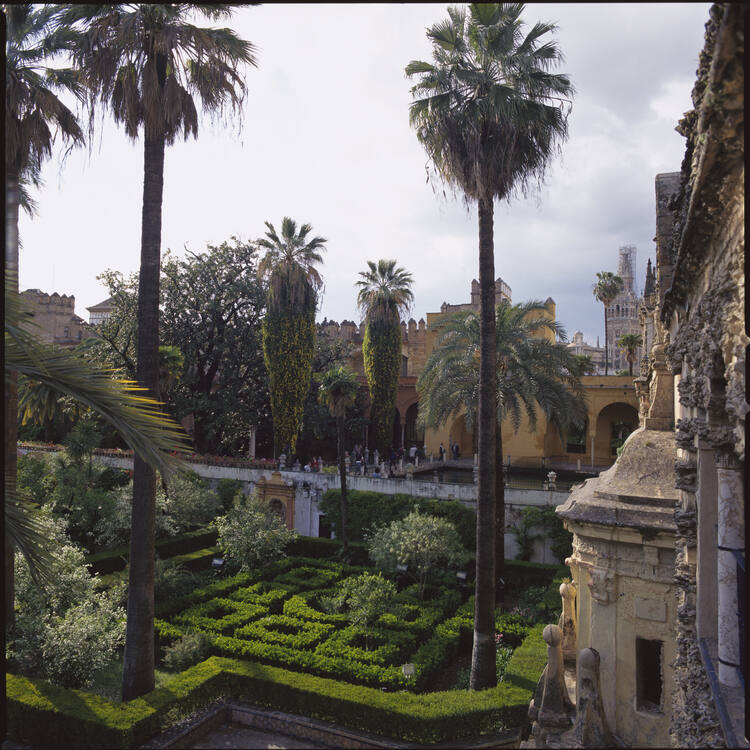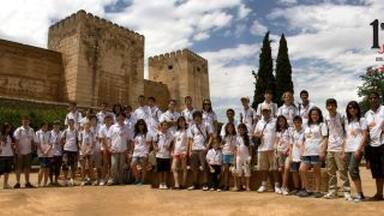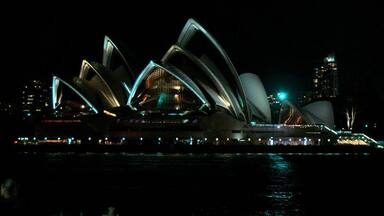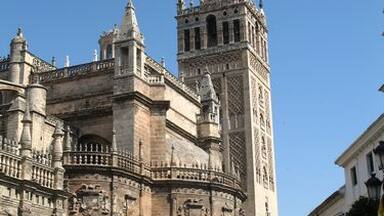Cathedral, Alcázar and Archivo de Indias in Seville
Cathedral, Alcázar and Archivo de Indias in Seville
Together these three buildings form a remarkable monumental complex in the heart of Seville. The cathedral and the Alcázar – dating from the Reconquest of 1248 to the 16th century and imbued with Moorish influences – are an exceptional testimony to the civilization of the Almohads as well as that of Christian Andalusia. The Giralda minaret is the masterpiece of Almohad architecture. It stands next to the cathedral with its five naves; the largest Gothic building in Europe, it houses the tomb of Christopher Columbus. The ancient Lonja, which became the Archivo de Indias, contains valuable documents from the archives of the colonies in the Americas.
Description is available under license CC-BY-SA IGO 3.0
La Cathédrale, l'Alcázar et l'Archivo de Indias de Séville
Les trois bâtiments constituent un admirable ensemble monumental au cœur même de Séville, les deux premiers apportant un témoignage exceptionnel sur la civilisation des Almohades et sur l'Andalousie chrétienne, toute pénétrée d'influences maures depuis la Reconquête de 1248 jusqu'au XVIe siècle. Le minaret de la Giralda, chef-d'œuvre de l'architecture almohade, jouxte la cathédrale à cinq nefs, qui est le plus grand édifice gothique d'Europe et abrite le gigantesque tombeau de Christophe Colomb. L'ancienne Lonja, devenue Archivo de Indias, conserve les plus précieuses des archives relatives aux colonies d'Amérique.
Description is available under license CC-BY-SA IGO 3.0
تشكّل المباني الثلاثة مجموعةً كبيرة رائعةً في قلب أشبيلية. والمبنيان الأولييان يُشكلان شهادةً استثنائيّةً على حضارة الموحدين وعلى الأندلس المسيحي الذي دخلته تأثيرات عربية مباشرة منذ الفتح الثاني عام 1248 وحتّى القرن السادس عشر. ومئذنة جيرالدا وهي تحفة من الهندسة ذات الطابع الموحدي تقف إلى جانب الكنيسة ذات الخمسة أجنحة وهي أعظم مبنى قوطي في أوروبا وفيه ضريح كريستوف كولومبوس. ولونخا القديمة أصبحت "أرشيف الهند" وفيها أغلى أرشيفات مستعمرات أمريكا.
source: UNESCO/CPE
Description is available under license CC-BY-SA IGO 3.0
位于塞维利亚中心的三座建筑——大教堂、城堡和西印度群岛档案馆——共同组成了非凡的古迹建筑群。大教堂和城堡的历史可以追溯到收复领土的1248年至公元16世纪间,这两个建筑受到了摩尔人风格的影响,同时,它们也是阿尔默哈德文明和信奉基督教的安达卢西亚文明的历史见证。西拉尔达大寺院是阿尔默哈德时代的建筑杰作,在它旁边是塞维利亚大教堂,该大教堂共有五个大殿,是欧洲最大的哥特式建筑,教堂中存放着克里斯托弗·哥伦布的棺墓。西印度群岛档案馆由一个拍卖厅改建而成,馆中存放着早期殖民者发现美洲时的宝贵档案文献。
source: UNESCO/CPE
Description is available under license CC-BY-SA IGO 3.0
Все вместе эти три здания составляют замечательную группу памятников, расположенную в самом центре Севильи. Кафедральный собор и Алькасар относятся к периоду от реконкисты 1248 г. до XVI в. и отражают влияние мавританского стиля, являясь важным свидетельством как цивилизации Альмохадов, так и христианской Андалусии. Минарет Хиральда – это шедевр архитектуры времен Альмохадов. Он стоит рядом с кафедральный собором с пятью нефами, который является крупнейшим готическим зданием Европы. Здесь находится саркофаг Христофора Колумба. Древняя Лонха (биржа) стала “Архивом Индий”, содержащим ценные документы из всех архивов испанских колоний в Америке.
source: UNESCO/CPE
Description is available under license CC-BY-SA IGO 3.0
Catedral, alcázar y Archivo de Indias de Sevilla
Estos tres edificios forman un conjunto monumental admirable en el corazón de Sevilla. La Catedral y el Alcázar son dos testimonios excepcionales de la civilización almohade y de la Sevilla cristiana, cuyo arte estuvo muy impregnado de la influencia musulmana desde la reconquista de la ciudad (1248) hasta el siglo XVI. El antiguo minarete de la Giralda, obra maestra de la arquitectura almohade, se yergue al costado de la catedral. Esta iglesia de cinco naves es el edificio gótico más grande de Europa y alberga la colosal sepultura de Cristóbal Colón. En la antigua lonja, convertida en Archivo de Indias, se conservan fondos documentales inestimables de las colonias españolas en América.
source: UNESCO/CPE
Description is available under license CC-BY-SA IGO 3.0
Kathedraal, Alcázar en Archivo de Indias in Sevilla
Source: unesco.nl
Outstanding Universal Value
Brief synthesis
Together the Cathedral, Alcázar and Archivo de Indias as a series, form a remarkable monumental complex in the heart of Seville. They perfectly epitomize the Spanish "Golden Age", incorporating vestiges of Islamic culture, centuries of ecclesiastical power, royal sovereignty and the trading power that Spain acquired through its colonies in the New World.
Founded in 1403 on the site of a former mosque, the Cathedral, built in Gothic and Renaissance style, covers seven centuries of history. With its five naves it is the largest Gothic building in Europe. Its bell tower, the Giralda, was the former minaret of the mosque, a masterpiece of Almohad architecture and now is important example of the cultural syncretism thanks to the top section of the tower, designed in the Renaissance period by Hernán Ruiz. Its "chapter house" is the first known example of the use of the elliptical floor plan in the western world. Ever since its creation, the Cathedral has continued to be used for religious purposes.
The original nucleus of the Alcázar was constructed in the 10th century as the palace of the Moslem governor, and is used even today as the Spanish royal family's residence in this city, thereby retaining the same purpose for which it was originally intended: as a residence of monarchs and heads of state. Built and rebuilt from the early Middle Ages right up to our times, it consists of a group of palatial buildings and extensive gardens. The Alcázar embraces a rare compendium of cultures where areas of the original Almohad palace - such as the "Patio del Yeso" or the "Jardines del Crucero" - coexist with the Palacio de Pedro I representing Spanish Mudejar art, together with other constructions displaying every cultural style from the Renaissance to the Neoclassical.
The Archivo de Indias building was constructed in 1585 to house the Casa Lonja or Consulado de Mercaderes de Sevilla (Consulate of the merchants of Seville). It became the Archivo General de Indias in 1785, and since then it has become home to the greatest collection of documentation concerning the discovery of and relations with the New World. The Archivo de Indias, designed by the architect responsible for completing El Escorial, Juan de Herrera, is one of the clearest examples of Spanish Renaissance architecture. An enormous influence on Baroque Andalusian architecture and on Spanish neoclassicism, it symbolizes the link between the Old and the New World.
Seville owes its importance during the 16th and 17th centuries to its designation as the capital of the Carrera de Indias (the Indies route: the Spanish trading monopoly with Latin America). It was the "Gateway to the Indies" and the only trading port with the Indies from 1503 until 1718.
The Conjunto Monumental, or group of historic buildings encompassing the Cathedral/Giralda, the Alcázar and the Archivo de Indias, constitutes a remarkable testimony to the major stages of the city's urban history (Islamic, Christian, and that of Seville with its associations with the New World), as well as symbolizing a city that became the trading capital with the Indies for two centuries - a time during which Seville was the hub of the Spanish monarchy and played a major role in the colonization of Latin America following its discovery by Columbus.
Each one of these monuments is associated with the colonization process. The tomb of Columbus is preserved in the Cathedral. The Sala de los Almirantes (Admirals' hall) in the Alcázar was the headquarters of the Casa de Contratación (House of Trade), from which the monopoly with the Indies operated, and where, as a seat of learning, it spawned some of the most important expeditions of exploration and discovery of that period. And the Archivo de Indias has, since the 18th century, housed the most valuable and important documents which provide an insight into this historical event.
Criterion (i): The Giralda constitutes a unique artistic achievement, a masterpiece of Almohad architecture. The immense Cathedral with five naves which replaced the mosque is the largest Gothic edifice in Europe. The elliptical space of the Cabildo, created by Hernán Ruiz, is one of the most beautiful architectural works of the Renaissance.
Criterion (ii): The Giralda influenced the construction of numerous towers in Spain, and, after the conquest, in the Americas.
Criterion (iii): The Cathedral - the largest Gothic temple in Europe - and the Alcázar of Seville bear exceptional testimony to the civilization of the Alhomads and to that of Christian Andalusia dating from the re-conquest of 1248 to the 16th century, which was thoroughly imbued with Moorish influences.
Criterion (vi): The Cathedral, the Alcázar and the Lonja are directly and tangibly associated with a universally important event: the discovery of the New World by Christopher Columbus in 1492/1493 and the colonization of Latin America. The tomb of Christopher Columbus is in the Cathedral. Plans were made in the Admirals' Hall (Sala de los Almirantes) for a number of history's greatest explorations, notably the circumnavigation of the globe by Magellan and Sebastián ElCano (1519-1522). In the Lonja are conserved the most precious documents from the archives of the colonies in the Americas.
Integrity
The Conjunto Monumental retains in its configuration the physical integrity of the original buildings and the juxtaposition of the various major historical stages.
The Cathedral constitutes a fully-used and complete monument. A Gothic temple whose construction was begun at the beginning of the 15th century above Seville's former Mezquita Mayor - an Almohad building whose Patio de los Naranjos has been preserved and converted into the access courtyard to the Cathedral - and the Giralda - the minaret that has been reused as a bell tower. It clearly displays the original Gothic masonry construction. Similarly, the later Renaissance buildings such as the Sala Capitular (Chapter House) retain their original fabric.
The Alcázar is another monument that retains the integrity of the phases of the various periods in which it was built. The rooms, patios and gardens of the original Almohad palace are preserved in their original state, as are the Mudejar constructions that make up the Palacio de Pedro l and the remaining later constructions and gardens that comprise the present-day Conjunto Monumental.
The Archivo de Indias building is preserved in its entirety, along with the valuable documents that it contains.
Authenticity
Each of the three buildings reflects clearly its architectural histories and convey their roles in the Spanish "Golden Age" in terms of ecclesiastical power royal sovereignty and the trading power that Spain acquired through its colonies in the New World.
In the restricted perimeter covered by the property, the three buildings are the most important manifestations of the power and influence of Spanish trade in the Americas. They are however not the only manifestations in the city and to reinforce their ability to convey the outstanding universal value of the property, there is a need to allow them to be associated with other remaining buildings.
The authenticity of the series of three buildings is to a degree vulnerable to changes in their setting which could leave them isolated from other associated buildings.
Protection and management requirements
Maintaining the Outstanding Universal Value remains guaranteed as long as individual protective mechanisms are in place for each one of the inscribed properties. The three buildings enjoy the highest degree of protection that exists in heritage legislation, at both regional and national levels, since they have been declared to be Properties of Cultural Interest in the Monuments category.
Similarly guaranteed are the conservation of individual buildings also associated with the Spanish trade in the Americas in the historical heart of the city that serves as the urban setting for the three monuments and the general characteristics of that urban environment. Fulfilling the legal requirement for the existence of specific urban plans and catalogues for its protection, this area, as a whole has been declared a Property of Cultural Interest. Given the enormous extent of this Conjunto Histórico, the protection plans have been drawn up according to homogeneous sectors. These Special Plans and Catalogues, together with the General Plan that came into force in 2006 (for those sectors whose Catalogue has yet to be completed), establish adequate measures for protection of the immediate setting of the property.
There are currently no action plans for the three buildings. However, there are provisions for improving the area included within a buffer zone whose boundary is under consideration.
In the medium term, provisions made by the City Council include the completion of the Catalogues of buildings to be protected in both of the Conjunto Histórico sectors that have not yet been drawn up (sector 7, "Cathedral Sector" and sector 8, "Encarnación-Magdalena Sector") to replace the current precatalogues.
In the medium term, there are plans to restore two buildings in the proposed buffer zone that relate to the colonization of Latin America, the Atarazanas (shipyard) and the San Telmo palace.
Links
-
Ministerio de Educación (in spanish)
-
Catedral de Sevilla (in Spanish)
-
Ministerio de Educación (in Spanish)
-
Real Alcázar de Sevilla
-
 View photos from OUR PLACE the World Heritage collection
View photos from OUR PLACE the World Heritage collection
-
World Heritage Sites in Spain (Tourist Office of Spain)
-
Ayuntamiento de Sevilla (only in spanish)
-
Ministerio de Educación, Culture y Deporte (only in spanish)





